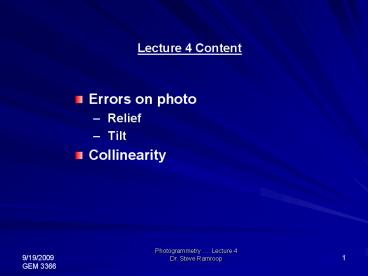Photogrammetry . Lecture 4 PowerPoint PPT Presentation
1 / 23
Title: Photogrammetry . Lecture 4
1
- Lecture 4 Content
- Errors on photo
- Relief
- Tilt
- Collinearity
2
- Errors on photograph
- A map is an orthogonal projection of the ground
surface onto a sea level sphere - Camera errors
- Projection is reduced further to a plane
- Small extent areas, gives a good approximation to
the terrain.However, it is not so for large
extents - A vertical projection is a central projection
- Therefore, if a map and a photo is overlaid,
there will be little coincidence over the whole
photo - Discrepancies are due to the terrain relief and
camera tilt
3
Internal Sensor Errors
- Lens distortion and errors cause the light rays
to deviate
4
- All aerial cameras have a calibration report
(Continued)
5
- All aerial cameras have a calibration report
(Continued)
6
- All aerial cameras have a calibration report
(Continued)
7
- All aerial cameras have a calibration report
8
Planimetrically Correct
Orthorectification creates planimetrically
correct images, which display no relief
displacement
3D View
9
- Relief
Map Scale
C
d
f
Two triangles AAA and Coa are similar,
therefore
a
o
a
Nadir Point
H
r
A
rh
D
or
f
h
Substituting
rhf
d
fH
or
A
A
D
10
- Relief
- This error is the shift of photographic position
of an object with respect to the photographic
position of its orthogonal projection onto the
datum plane - Caused by the variations in the terrains relief
- Relief error occurs along the radial lines from
- the nadir point
11
- Tilt
- This is the shift of photographic position of an
object with respect to its image taken from the
same exposure station with truly vertical camera
axis
A
B
A
B
12
C
f
b
a
Vertical Photo
d
e
H
D
E
A
B
13
- Only one line is common to both the vertical and
tilted photographs - Called the isoline or axis of tilt
- Intersection with principal line is the isocenter
y
Principal line and tilt axis on a tilted photo
e
Isoline (axis of tilt)
e
s
i
o
x
i
n
i
a
Principal line
(180-s)
a
14
- Points a and b, being on the downside of the
isoline, are displaced radially from the
isocenter (i) - Points d and e, are shifted radially towards (i)
because they are above the isoline - When tilt and relief displacements compound each
other, the geometric treatment becomes impractical
15
- Epipolar lines and planes
16
- Two photos, a ground point, G, and its images, g1
and g2 - Camera locations are C and C
- Points C, C and G all lie on a plane and such a
plane is called an epipolar plane - Such a plane intersects the two photos along a
line and on each photo - Such a line on the photo is called an epipolar
line - Each epipolar line in a pair of photographs is
conjugate to the other - This concept is useful for digital photogrammetry
17
Collinearity Condition
- A line extending from
the exposure station
to the image point
and to the ground point
must be linear
This condition is used to mathematically relate
image and ground measurements to the Exterior
Orientation parameters
18
- Collinearity
- to reconstruct a model in the object space from
measurements on photographs, use is made of
mathematical models that represent the
relationship between points in the object space,
the perspective center, and parameters of the
camera - X,Y,Z Cartesian coordinate system is used as a
reference for object space - x,y,z Cartesian coordinate system is used to
reference the image space - Object coordinates of the perspective center is
Xc, Yc, Zc where Zc is the flying height of the
camera above the datum - Object coordinates of the ground point A is XA,
YA, ZA
19
Need to get the coordinates of the point a
defined on the image coordinate system and also
get the coordinate of the similar point A on
the object coordinate system (ground control)
20
- The image vector from the perspective center
C to the image point and the object vector
from to the object point - are collinear
- These points should also be collinear during
photogrammetric reconstruction and data reduction - Two vectors are said to be collinear if one is a
scalar multiple of the other
a
C
A
21
- a kA equation 1
- Where k is a scalar that is equal to the ratio of
the length of a to the length A - If the two vectors are referred to the same
coordinate system then
- Substituting into equation 1
Where M is the orientation matrix defined to
rotate the image system to become parallel to the
object system
22
(No Transcript)
23
- The End

